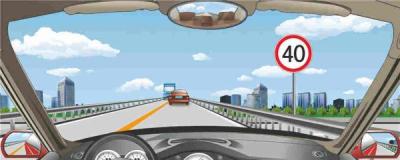1、As shown in the flash, when overtaking a vehicle in front, the driver should make the horizontal distance as large as possible and may cross the solid line if necessary.

A、Right
B、Wrong
Answer:B
2、Motor vehicles are not permitted to change lanes in this position.

A、Right
B、Wrong
Answer:A
3、When parking for a long time on a downward slope due to breakdown on the road, drivers should use this method to stop up wheels.

A、Right
B、Wrong
Answer:A
4、Under such circumstances, motor vehicles are not allowed to overtake.

A、Right
B、Wrong
Answer:A
5、Under such circumstances, what should motor vehicle drivers do?

A、Guard against the sideslip of motor vehicles
B、Guard against the crossing of pedestrians
C、Speed up and pass through as quickly as possible
D、Continuously sound the horn
Answer:B
6、What's the main impact of foggy weather on safe driving?
A、Easy to slide sideways
B、Low visibility
C、Increase the resistance
D、Widen the field of vision
Answer:B
7、It is a bad habit for a driver to put his left arm on the window of the vehicle or hold the gear lever in his right hand for a long time.
A、Right
B、Wrong
Answer:A
8、What should the driver do when the motor vehicle passes a flyover?

A、Speed up and pass rapidly
B、Keep the speed under 15 km/hour
C、Drive at the speed indicated by the traffic sign
D、Drive close to the central line of the flyover
Answer:C
9、When driving in a strong wind, what should the driver do if he/she feels the steering wheel is suddenly out of control due to the frequent changes in speed and direction of the wind?
A、Turn the steering wheel against the wind
B、Turn the steering wheel with the wind
C、Use emergency brake
D、Firmly hold the steering wheel with both hands
Answer:D
10、What should the driver do upon finding that one ofthe right tires is leaking while driving?
A、Brake swiftly to slow down
B、Brake slowly to slow down
C、Turn to the left side swiftly
D、Apply emergency braking
Answer:B
11、The sign on the right warns of a guarded railway crossing 100 meters ahead.

A、Right
B、Wrong
Answer:B
12、The sign on the right warns of an unguarded railway intersection ahead.

A、Right
B、Wrong
Answer:B
13、The sign on the right side warns of an emergency lane 500 meters ahead.

A、Right
B、Wrong
Answer:A
14、Motor vehicle drivers are allowed to overtake on this road section.

A、Right
B、Wrong
Answer:B
15、When there is a braking failure on a downhill road, if there is no favorable terrain or opportunity to stop the vehicle, the driver should drop gear by one position or two positions, and control the speed by taking advantage of the braking role of the engine.
A、Right
B、Wrong
Answer:A
16、When encountering such pedestrians, what should motor vehicle drivers do?

A、Bypass in front of the pedestrians
B、Bypass from behind the pedestrians
C、Sound the horn to alert the pedestrians
D、Voluntarily stop and yield
Answer:D
17、When driving on a road covered with ice and snow, the motor vehicle may spin or slide when increasing the speed urgently, due to the loss of vehicle stability.
A、Right
B、Wrong
Answer:A
18、The road marking on the right lane indicates that drivers may temporarily borrow the special lane for buses.

A、Right
B、Wrong
Answer:B
19、After a motor vehicle enters the ramp from an expressway, it should reduce its speed below the prescribed speed limit.
A、Right
B、Wrong
Answer:A
20、The diamond-shaped broken line warns that drivers should drive at a lower speed on the road sections ahead.

A、Right
B、Wrong
Answer:A